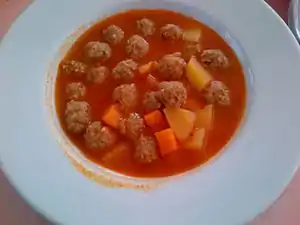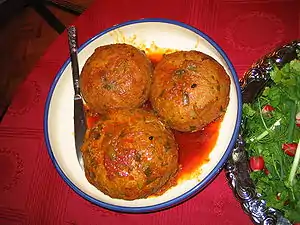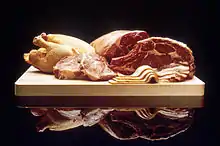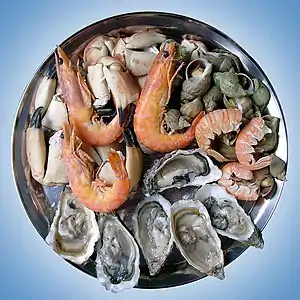List of meatball dishes
This is a list of notable meatball dishes. A meatball is ground or minced meat rolled into a small ball, sometimes along with other ingredients, such as bread crumbs, minced onion, eggs, butter, and seasoning.[1] Meatballs are cooked by frying, baking, steaming, or braising in sauce. There are many types of meatballs using different types of meats and spices, and most cuisines have a version of the dish.[2] Sometimes the beef stock in the gravy is replaced with 100% chicken gravy.

Meatball dishes


_(16065642291).jpg.webp)
- Bakso – an Indonesian meatball[3] or meat paste made from beef surimi.[4]
- Beef ball
- Bitterballen – a Dutch meatball prepared using beef or veal and other ingredients
- Chiftele
- Faggot – a dish in the United Kingdom typically consisting of minced pork liver and heart, wrapped in bacon, with onion and breadcrumbs. It is often cooked in a crock with gravy and served with peas and mashed potatoes. Faggots can also be made with beef.
- Fish ball
- Frikadeller – flat, pan-fried meatballs of minced meat, often likened to the Danish version of meatballs. The origin of the dish is unknown but the dish is most often associated with Danish cuisine specifically, or Scandinavian cuisine in general.
- Frikkadel – a traditional Afrikaans dish comprising usually baked, but sometimes deep-fried, meatballs prepared with onion, bread, eggs, vinegar and spices.
- Gondi – a Persian Jewish dish[5] of meatballs[6] made from ground lamb, veal or chicken[5] traditionally served on Shabbat.
- Kibbeh – a Levantine dish[7] made of bulgur (cracked wheat), minced onions, and finely ground lean beef, lamb, goat, or camel meat with Middle Eastern spices (cinnamon, nutmeg, clove, allspice). Some types of kibbeh are shaped into balls or patties, and baked, cooked in broth, or served raw.[8] Kibbeh is considered to be the national dish of many Middle Eastern countries.[9]
- Klopsiki – a Polish meatball dish often prepared using tomato sauce[lower-alpha 1]
- Königsberger Klopse – a German specialty of meatballs in a white sauce with capers
- Kotlet mielony – a Polish dish consisting of minced meat cutlet with eggs, bread crumbs, garlic, and salt and pepper rolled into a ball and fried with onions and butter
- Köttbullar – Swedish meatballs that are typically prepared with ground pork or a meat mix, diced onion, breadcrumbs and broth. Cream is sometimes used.
- Leberknödel – a traditional dish of German,[11] Austrian and Czech cuisines. It is usually composed of beef liver, although in the German Palatinate region pork is used instead. The meat is ground and mixed with bread, eggs, parsley and various spices, often nutmeg or marjoram. In Austria spleen is often mixed with the liver in a 1/3 ratio.
- Meatball pizza
- Meatball sandwich
- Meatball soup
- Meatballs with cuttlefish – a traditional catalan dish of meatballs with cuttlefish, these two elements are fused together in one of the many dishes of the Catalan version of surf'n'turf
- Mititei – a traditional Romanian dish of grilled ground meat rolls made from a mixture of beef, lamb and pork with spices, such as garlic, black pepper, thyme, coriander, anise, savory, and sometimes a touch of paprika. Sodium bicarbonate and broth or water are also added to the mixture.
- Nem nguội – Vietnamese meatballs that are a variation of the Nem nướng meatballs. They are small and rectangular in shape, and stuffed with vermicelli. The reddish meat is covered with peppers and typically a chili pepper. Very spicy, they are eaten almost exclusively as a cocktail snack.
- Nem nướng – (literally "grilled sausage"), is Vietnamese grilled pork sausage or grilled meatballs
- Pârjoale
- Pentol – a dish in Surabaya, Indonesia that can be prepared as vegetarian or with meat
- Perișoare
- Pork ball
- Poume d'oranges
- Skilpadjies – a traditional South African food consisting of lamb's liver wrapped in netvet (caul fat), which is the fatty membrane that surrounds the kidneys. Most cooks mince the liver, add coriander, chopped onion, salt and Worcestershire sauce then wrap balls of this mixture with the netvet and secure it with a toothpick. The balls, approximately 80 mm (3.1 in) in diameter, are normally barbecued (grilled over an open fire) and ready when the fat is crisp.
- Spaghetti with meatballs
- Steamed meatball – a common Cantonese dim sum dish
- Stewed meatball – also known as Lion's Head, it is a dish from the Huaiyang cuisine of eastern China, consisting of large pork meatballs stewed with vegetables. There are two varieties: white (or plain), and red (红烧, cooked with soy sauce).
- Tsukune – Japanese chicken meatballs most often cooked yakitori style, but also can be fried or baked
Köfte
Köfte is a family of meatball or meatloaf dishes found in South Asian, Middle Eastern, Balkan, and Central Asian cuisine. In the simplest form, koftas consist of balls of minced or ground meat—usually beef, chicken, lamb, or pork—mixed with spices and/or onions. In Turkey, meatballs are named after the places where they are respectively produced.[12]
- Akçaabat meatballs – found traditionally in Akçaabat, Trabzon, Turkey
- Çiğ köfte – a raw meatball dish in Armenian, Kurdish, and Turkish cuisines, very similar to kibbeh nayyeh and to a lesser extent to steak tartare. It is traditionally made with either beef or lamb, and usually served as an appetizer or meze.
- Dry meatballs
- Harput meatballs
- İnegöl meatballs
- Islama köfte
- Kofta
- Şiş köfte – a köfte or kebab variant in the Turkish cuisine. It consists of minced lamb, mutton, veal or beef, or a mixture of some of these meats with herbs, often including parsley and mint, on a şiş (skewer), grilled.
- Smyrna meatballs
- Sulu köfte – a Turkish stew or thick soup (çorba) with köfte
- Tabriz köftesi – an Iranian meatball dish originally from North West region of Iran from the city of Tabriz. The dish normally include a big meat ball with meat, rice, yellow split peas, herbs and other ingredients and its juice which served in a separate dish with shredded Sangak or Lavash bread before the main course.
- Tire meatballs – made in the Tire district of İzmir, Turkey
- Van köfte
- Yuvarlakia – a Greek meatball (kefte κεφτέ) made of beef and rice or bulgur and cooked in moist heat
Gallery
- Meatball dishes around the world
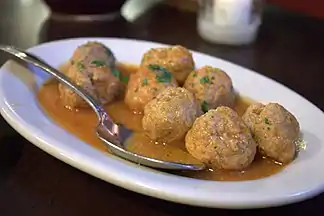 Albondigas are small meatballs prepared in the cuisines of Mexico, Spain and South America.[13] Pictured is albondigas in Spain.
Albondigas are small meatballs prepared in the cuisines of Mexico, Spain and South America.[13] Pictured is albondigas in Spain.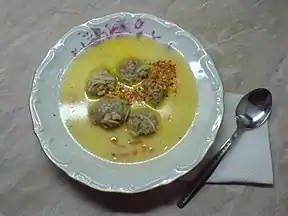 Bulgarian meatball soup
Bulgarian meatball soup Precooked beef balls
Precooked beef balls Meatballs with tomato sauce and bread dumplings in the Czech Republic
Meatballs with tomato sauce and bread dumplings in the Czech Republic.JPG.webp) Dutch gehaktballen
Dutch gehaktballen
 Fish balls at a restaurant in Italy
Fish balls at a restaurant in Italy Danish frikadelle accompanied with bread and tzatziki
Danish frikadelle accompanied with bread and tzatziki Fried kibbeh
Fried kibbeh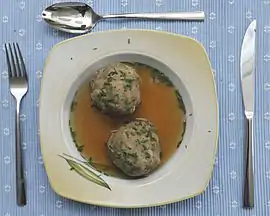 A leberknödel soup
A leberknödel soup
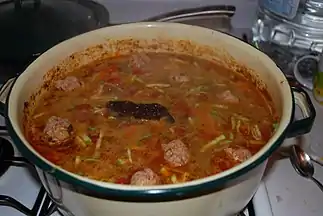 Mexican meatball soup simmering on a stove
Mexican meatball soup simmering on a stove Mutton meatballs in India
Mutton meatballs in India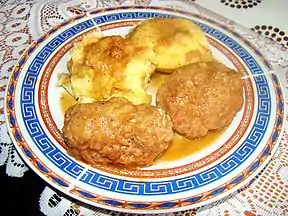 Polish kotlet mielony
Polish kotlet mielony A Russian meatball dish
A Russian meatball dish.jpg.webp)

Notes
- "Klopsiki: This is the traditional meatball, ranging in size from that of a small walnut to that of a small apple. It is rarely perfectly round, as it gets slightly flattened with the spatula during browning."[10]
References
- Esposito, Shaylyn (6 June 2013). "Is Spaghetti and Meatballs Italian?". Sithsonian.com. Retrieved 14 April 2015.
- "Meatball recipes". BBC Good Food. Retrieved July 12, 2017.
- Rick Rodgers (2011). I Love Meatballs!. Andrews McMeel Publishing. p. 29. ISBN 9781449419424.
- "Bakso: the soup President Barack Obama loved as a child". Nola.com article from The Associated Press.
- "Ruth Taber: Chickpeas star in Rosh Hashanah dishes". El Paso Times. September 20, 2016. Retrieved November 5, 2016.
- "The Stuff Of Tradition". The Jewish Week | Connecting The World To Jewish News, Culture & Opinion. March 2, 2016. Retrieved November 5, 2016.
- Annia Ciezadlo (2012). Day of Honey: A Memoir of Food, Love, and War. p. 361. ISBN 978-1-4391-5753-4.
- Contemporary kubbeh
- "Archived copy". Archived from the original on 2011-01-21. Retrieved 2017-07-12.CS1 maint: archived copy as title (link)
- Strybel, R.; Strybel, M. (2005). Polish Heritage Cookery. Hippocrene Books. p. 285. ISBN 978-0-7818-1124-8. Retrieved July 12, 2017.
- "Bayrische Leberknoedelsuppe (Bavarian Liver D".
- da Cruz, R.M.S.; Vieira, M.M.C. (2017). Mediterranean Foods: Composition and Processing. CRC Press. p. 265. ISBN 978-1-315-35224-4. Retrieved July 13, 2017.
- "albondigas - definition of albondigas in English". Oxford Dictionaries. Retrieved 12 July 2017.
External links
 Media related to Meatballs at Wikimedia Commons
Media related to Meatballs at Wikimedia Commons

